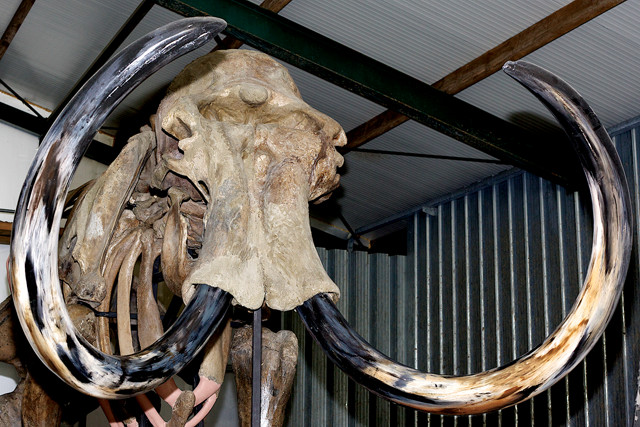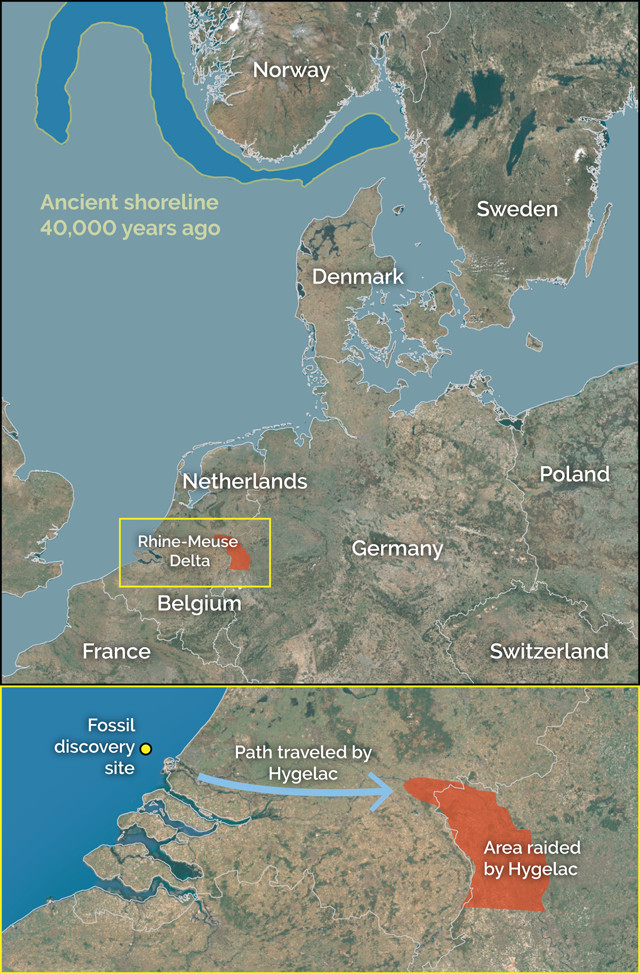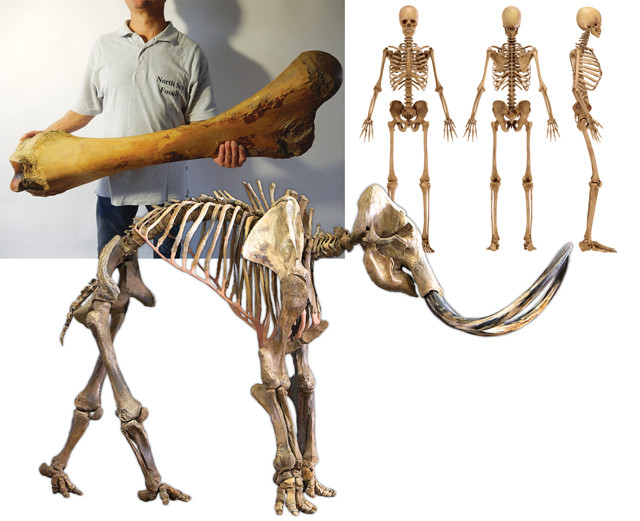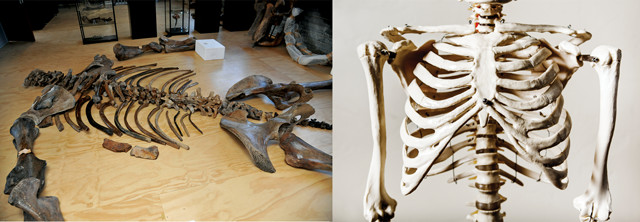
by TImothy J. Burbery Thursday, August 10, 2017

Could woolly mammoth remains, found in the area where legend suggests King Hygelac and his Viking raiders were buried, have been misidentified as human bones in the eighth century? Credit: Hans Wildschut, courtesy of North Sea Fossils.
As far-fetched as it may seem, the death of a woolly mammoth thousands of years ago on an island in the Rhine-Meuse River Delta, near present-day Rotterdam in the Netherlands, could have led, millennia later, to the monsters and characters of “Beowulf.” The road from pachyderm to poem has many twists and turns, and following it calls for some literary and scientific sleuthing.
“Beowulf,” a nearly 3,200-hundred-line epic poem, was written in Old English; it depicts the thrilling exploits of its eponymous hero, who clashes first with two humanoid monsters and then with a marauding dragon that has raided his country. Set in Scandinavia, it may have been composed as a tribute by the anonymous Anglo-Saxon author to his Danish forebears. Much about the poem is contested by scholars, including when it was written (estimates of which range from the seventh to the 11th centuries) and whether it started as an oral tale, a written one, or some combination thereof. Though largely fanciful, the poem contains some actual history.
Where science meets literature in the poem involves the titular character’s uncle (and king), Hygelac, the one undisputed historical person in the text. Hygelac’s death in or around A.D. 520 is well documented in numerous historical sources. He perished during a spectacular, disastrous raid on the Dutch coast. After leaving his homeland in southwestern Sweden and sailing toward what is now the Netherlands, Hygelac and his men put in at the Rhine River, moving far upriver to the settlements of the Hetware, a Germanic tribe in the area. Given the speed of their longships, the Vikings took the populace by surprise, seized prisoners and spoils, and then headed downstream to return home.
Upon reaching the river delta, their ships were so laden with plunder that Hygelac and a cohort of warriors disembarked, waiting on shore for another vessel with more room on it to ferry them home. The Vikings were soon counterattacked by forces commanded by Theodebert, son of King Theoderic. In the ensuing melee Hygelac and his men were killed, then buried, perhaps in a mass grave on or near the beach.
Among the sources corroborating the event is a fascinating, colorful treatise called the “Liber Monstrorum De Diversis Generibus” (“Book of Monsters of Various Sorts”), probably written in the early eighth century. In the first part of the “Liber,” the author claims that “there are monsters of an amazing size, like King Hygelac, who ruled the Geats [Scandinavian people of Southern Sweden] and was killed by the Franks [West Germanic people], whom no horse could carry from the age of twelve. His bones are preserved on an island in the river Rhine, where it breaks into the Ocean, and they are shown as a wonder to travelers from afar.”
Given that much of the “Liber” seems whimsical — it details Cyclopes, centaurs and other mythical creatures — few scholars have taken this description at face value. However, relatively recent fossil finds off the coast of the Netherlands in the North Sea may change that. For more than a hundred years, fishermen and scientists have been collaborating to study and classify the remains of prehistoric fauna dredged up by fishing boats off Rotterdam. Dick Mol, a Dutch paleontologist nicknamed “Sir Mammoth” for his expertise in the study of Pleistocene mammals, notes that in the last 100 years, many bones, as well as mammoth molars, tusks, hooves and teeth, have been brought up from the seafloor, and also uncovered on local beaches following inclement weather.
This area is rich in fossils because, during the Pleistocene, when the North Sea was approximately 120 meters lower than it is now, a land bridge linked present-day Britain and the Netherlands. It consisted of a cold, treeless steppe and featured watering holes that supported a variety of animals, including mammoths, woolly rhinos, hyenas and lions. In fact, the fauna were so abundant that Mol calls this area “the Serengeti with its coat on.” When the animals died, bones were preserved in sand and other sediment.

Maps of the land extent 40,000 years ago when sea levels were significantly lower, and of the purported route that King Hygelac and the Vikings took on their raid up the Rhine. The Vikings were allegedly killed by King Theodebert and his troops, and their bodies buried on an island in the Rhine-Meuse Delta. Bones were reportedly found on that island and attributed to Hygelac several centuries after the raid. But could the bones actually have been mammoths and other Pleistocene megafauna? Researchers have found many such bones in locations in the North Sea and the delta region, such as those off the coast of the Netherlands, that match the locations described in "Beowulf." Credit: K. Cantner, AGI, with help from Dick Mol.
Based on this information, I venture a hypothesis: Hygelac was an ordinary — though perhaps tall — Viking king. And what are described as his colossal bones in the “Liber” were actually mammoth bones, misidentified by their discoverer(s) as human bones.
Here’s a possible scenario: Following the successful, stunning defense of their homeland against the Viking marauders, the battlefield and the graves of Hygelac and his men would have been memorialized by the local populace, as they recounted how the plundering king was hoist by his own petard and slain by Theodebert’s troops. The local legend would have been kept alive for decades, or even centuries, until one day massive, somewhat humanoid bones in or near the area were dug up. These objects would have been shown to travelers and advertised as belonging to the vanquished king. The legend of the thwarted invaders, which had already been in circulation for years, would have been embellished by this apparent discovery of Hygelac’s hugeness, and then recorded in the “Liber.”
Now, it is not impossible that the unearthed remains did indeed belong to the king; he might well have been a very big man. However, it is more likely that they had originated from a large mammal, such as a woolly mammoth, and were then mistaken for the king’s remnants. Several observations reinforce the latter notion: First, Hygelac’s purported remains were unearthed in what we now know to be a bonanza of Pleistocene fossils along the coastal areas of modern-day Netherlands; this fact seems to be more than coincidental. Second, the claim by the “Liber” author about the bones implies that Hygelac was not merely big, but extremely large, that is, of superhuman dimensions, to the extent that he is listed with other prodigies such as the Cyclopes, Hercules and the Colossus of Rhodes. Third, in addition to their sheer size, the bones seem to have looked monstrous or animal-like, given the inclusion of the king in the “Book of Monsters.”

The bone structures of pachyderms and humans are close in appearance, particularly femurs, ribs and scapulae. Mammoth femurs, for example, are three times the size of human femurs and, to the untrained eye, look similar to human ones. Credit: clockwise from top left: North Sea Fossils; ©iStockphoto.com/Cosmin4000; Hans Wildschut, courtesy of Dick Mol.
As folklorist Adrienne Mayor has shown in her book “The First Fossil Hunters: Dinosaurs, Mammoths, and Myth in Greek and Roman Times,” the bone structures of pachyderms and humans are close in appearance, particularly femurs, ribs and scapulae. Mammoth femurs, for example, are three times the size of human femurs and, to the untrained eye, look similar to human ones. Mayor makes a strong case that such bones were often discovered in ancient Greece and then mistaken for giants such as Ajax, Orestes, Achilles and Cyclopes. There may have been similar confusion with the king’s putative bones.
If you buy that the “Liber” inadvertently relied on mammoth bones for Hygelac’s description, the next step is to link the “Liber” with “Beowulf.” There is no scholarly consensus on whether the “Liber” influenced “Beowulf,” and the timing is challenging because we don’t know exactly when either was written, or by whom. Still, some researchers cite shared imagery in the texts as evidence that one author could have known of the other’s work.
If we consider size descriptions alone, the evidence is not conclusive. In “Beowulf,” Hygelac is generally described as tall but not colossal, although there are hints of his sizeable stature: He goes to his death on the battlefield, for example, wearing the largest gold torque — a stiff, metal neck-ring or collar — ever seen on Earth, according to the poet. Another possibility is that Hygelac’s largeness in the “Liber” is transferred in the poem to his nephew, Beowulf himself, who is unambiguously described as “mighty,” “huge,” “the largest man ever,” and with other such descriptors. Yet another possibility is that Grendel, one of the poem’s three monsters, reflects Hygelac’s enormity in the “Liber.” Grendel is frequently described as a giant — one who is capable, for instance, of scooping up 30 men into a bag.

Mammoth ribs versus human ribs. Credit: left: North Sea Fossils; right: ©iStockphoto.com/Renphoto.
Others have postulated that Hygelac’s gigantism in the “Liber” could have been taken by the “Beowulf” poet in a metaphorical sense; that is, he might be “monstrous,” not physically, but in terms of his arrogance. Hygelac’s rash action in initiating the raid is a repeated motif in the poem, and the king serves as a cautionary tale for Beowulf, who could also be tempted to indulge in a similar type of pride.
Yet another potential link between “Beowulf” and the “Liber” is that both texts refer to Hygelac as a “Geat” rather than a “Dane,” as he is designated in two earlier sources, the “Historia Francorum,” by Gregory of Tours, and the anonymous “Liber Historiae Francorum.” Given that Gregory died in A.D. 594, his allusion to Hygelac’s death is probably the earliest mention of it. The subsequent alteration of the king’s nationality in the “Liber” and in “Beowulf” may be a nod to a mythical tradition that the Geats, traditionally regarded as hailing from southwest Sweden, were, in fact, descended from the Goths, themselves purportedly descendants of the Titans — the giants who contended against the gods in antiquity. The revision of the protagonist’s nationality may have been a way for the “Beowulf” poet to implicitly attribute gigantic size to Hygelac.
None of these connections can be proven at this point, and indeed, may never be. Until further archaeological evidence about Hygelac and his raid, or supporting historical and literary texts, come to light, the relationships raised here — that Hygelac’s imposing stature might have been inspired by the unearthing of, and subsequent misattribution of, Pleistocene fauna, and/or that “Beowulf” may have borrowed from the “Liber’s” fanciful account of Hygelac — will have to remain no more than beguiling possibilities.
© 2008-2021. All rights reserved. Any copying, redistribution or retransmission of any of the contents of this service without the expressed written permission of the American Geosciences Institute is expressly prohibited. Click here for all copyright requests.